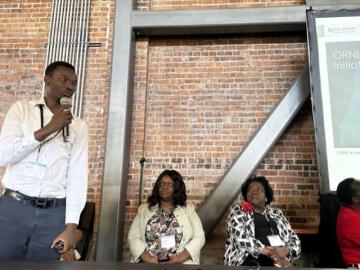
Filter News
Area of Research
- Advanced Manufacturing (5)
- Biological Systems (2)
- Biology and Environment (76)
- Computational Biology (2)
- Computational Engineering (2)
- Computer Science (7)
- Electricity and Smart Grid (1)
- Energy Science (71)
- Functional Materials for Energy (1)
- Fusion and Fission (5)
- Isotope Development and Production (1)
- Isotopes (27)
- Materials (54)
- Materials for Computing (9)
- National Security (38)
- Neutron Science (18)
- Nuclear Science and Technology (10)
- Quantum information Science (3)
- Sensors and Controls (1)
- Supercomputing (70)
News Topics
- (-) Bioenergy (112)
- (-) Composites (35)
- (-) Cybersecurity (35)
- (-) High-Performance Computing (130)
- (-) Hydropower (12)
- (-) Isotopes (62)
- (-) Machine Learning (68)
- (-) Polymers (35)
- (-) Security (31)
- (-) Space Exploration (26)
- 3-D Printing/Advanced Manufacturing (146)
- Advanced Reactors (40)
- Artificial Intelligence (131)
- Big Data (79)
- Biology (128)
- Biomedical (73)
- Biotechnology (39)
- Buildings (74)
- Chemical Sciences (86)
- Clean Water (33)
- Computer Science (226)
- Coronavirus (48)
- Critical Materials (29)
- Education (5)
- Element Discovery (1)
- Emergency (4)
- Energy Storage (114)
- Environment (218)
- Exascale Computing (67)
- Fossil Energy (8)
- Frontier (64)
- Fusion (66)
- Grid (74)
- Irradiation (3)
- ITER (9)
- Materials (157)
- Materials Science (158)
- Mathematics (12)
- Mercury (12)
- Microelectronics (4)
- Microscopy (56)
- Molten Salt (10)
- Nanotechnology (64)
- National Security (86)
- Neutron Science (171)
- Nuclear Energy (122)
- Partnerships (68)
- Physics (69)
- Quantum Computing (53)
- Quantum Science (92)
- Simulation (65)
- Software (1)
- Statistics (4)
- Summit (71)
- Transportation (103)
Media Contacts

A research collaboration between the Department of Energy’s Oak Ridge National Laboratory and several partner institutions was honored with the Best Event Report award at the 2024 International Conference on Game Jams, Hackathons and Game Creation Events.

Scientists and land managers interested in accessing the first dataset of its kind on one of the most biologically diverse ecosystems in the world were given hands-on tutorials during a recent workshop by researchers supporting the ORNL Distributed Active Archive Center for Biogeochemical Dynamics.

FREDA is a new tool being developed at ORNL that will accelerate the design and testing of next-generation fusion devices. It is the first tool of its kind to combine plasma and engineering modeling capabilities and utilize high performance computing resources.

The Department of Energy’s Oak Ridge National Laboratory had a major presence at this year’s International Conference for High Performance Computing, Networking, Storage, and Analysis (SC24).


Scientists at the Department of Energy’s Oak Ridge National Laboratory recently demonstrated an autonomous robotic field monitoring, sampling and data-gathering system that could accelerate understanding of interactions among plants, soil and the environment.

ORNL researchers reached a significant milestone by building an entire 6.5-foot turbine blade tip using novel materials. The team then tested it against the forces of simulated lightning in a specialized lab at Mississippi State University, where the blade tip emerged pristine after tests that isolate the effects of high voltage.

A team of scientists with two Department of Energy Bioenergy Research Centers — the Center for Bioenergy Innovation at Oak Ridge National Laboratory and the Center for Advanced Bioenergy and Bioproducts Innovation at the University of Illinois Urbana-Champaign — identified a gene in a poplar tree that enhances photosynthesis and can boost tree height by about 30% in the field and by as much as 200% in the greenhouse.

From during his early years at NASA to his current role a researcher and group leader, Peter Fuhr has pushed the boundaries of optical and sensor technology. Fuhr’s path is marked by wacky creativity that can’t confine itself to challenges in a single field. No idea is too far out to try out — and so many of them work that Fuhr has a host of inventions and start-ups under his belt.

This year’s Association for Computing Machinery’s Gordon Bell Prize in supercomputing goes to researchers led by the University of Melbourne who used the Frontier supercomputer to conduct a quantum molecular dynamics simulation 1,000 times greater in size and speed than any previous simulation of its kind.


